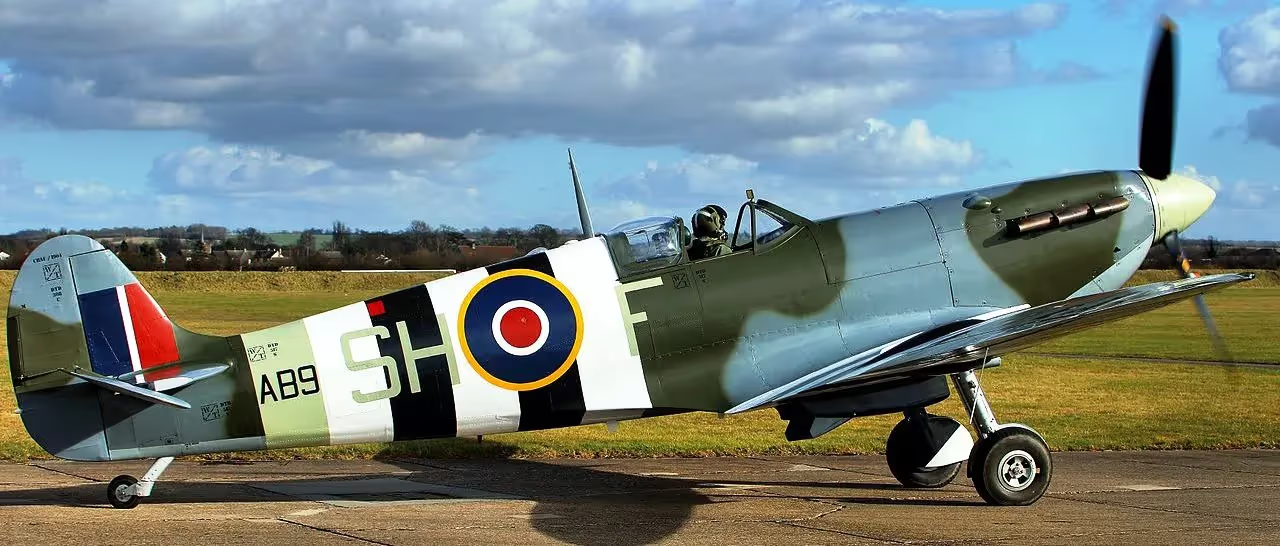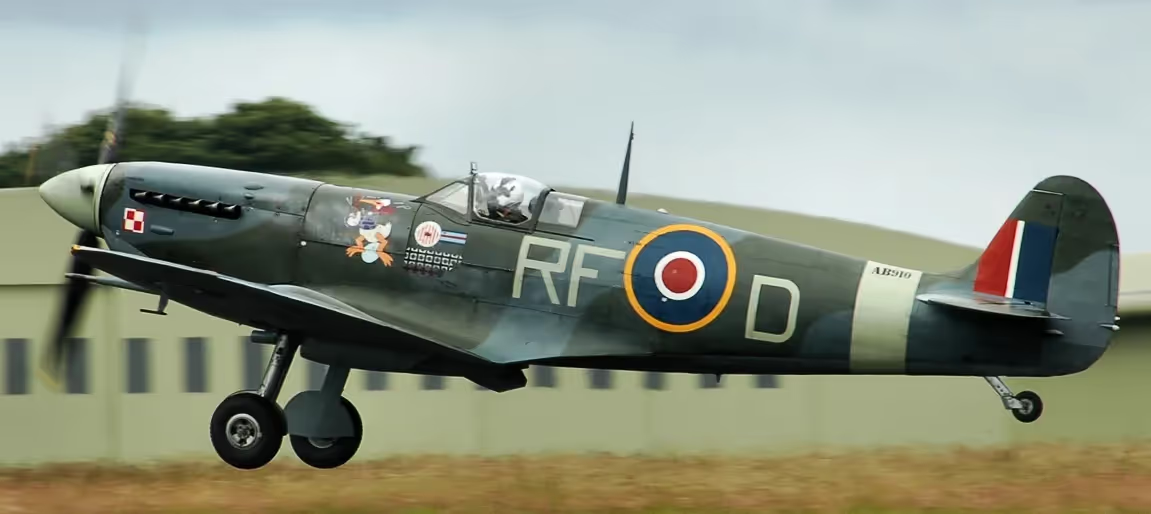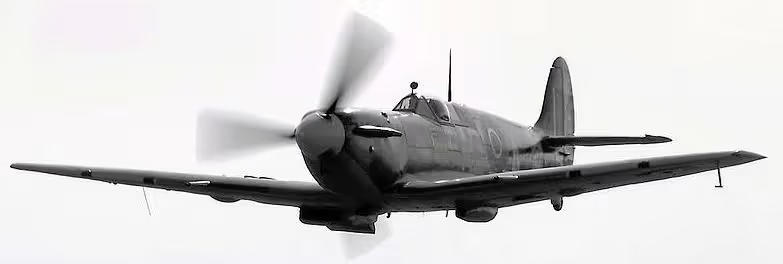Warplanes of the UK: Supermarine Spitfire Mk. V
Supermarine Spitfire Mk. V

(IWM Photo, CH 2929)
Supermarine Spitfire Mk Vb (Serial R6923), No 92 Squadron RAF based at Biggin Hill, Kent, UK. 6923 was originally a Mk. I, converted to a Mk. V after serving with No. 19 Squadron and No. 7 Operational Training Unit in 1940. It was shot down over the sea by a Messerschmitt Me 109F on 22 June 1941.

(RAF Photo)
upermarine Spitfire Vb formation on a patrol over Djerba Island, off Gabes, on their way to the Mareth Line area in early 1943. The planes "UF-V" and "UF-F" belonged to No. 601 Squadron. The plane "IR-G" (Serial No. AB502) in the foreground was the personal plane of Ian Richard Gleed, DFC, Wing Commander of No. 244 Wing. On 16 April 1943 Gleed lost his life in a fighter sweep in the Cap Bon area. He was shot down in his Spitfire by German Messerschmitt Bf 109Gs from JG 77.

(Anthony Noble Photo)


(John5199 Photos)



(Sgt Jack Pritchard Photos)


(Tim Felce Photos)

(plambertuk Photo)

(Adrian Pingstone Photo)
Supermarine Spitfire LF Mk. Vb (Serial No. AB910), RF-D, 303 (Polish) Squadron, previously SH-L, Battle of Britain Memorial Flight, RAF Coningsby, Lincolnshire. Airworthy. Built at Castle Bromwich in 1941, this Spitfire was flown on front line operations for almost four years. (Wikipedia)

(tataquax Photo)

(Photokora Photo)

(Mark Harkin Photo)

(Ad Meskens Photo)

(Tony Hisgett Photo)

(Alan Wilson Photo)

(Kogo Photo)

(John5199 Photo)





(Tim Felce Photos)

(Ronnie Macdonald Photo)

(tataquax Photo)

(Anthony Noble Photo)

(Peter Bakema Photo)

(Mike Freer - Touchdown-aviation Photo)
Supermarine Spitfire F Mk. Vb (Serial No. BM597), Reg. No. G-MKVB, JH-C, 317 Polish Squadron, Historic Aircraft Collection, Duxford, Cambridgeshire. Airworthy. This fighter has been repainted to represent a Mk. IIb (Serial No. P8331) "Sumatra", No. 303 Squadron, RAF, flown by Polish Wing Commander Piotr Laguna in 1941. Owned by Historic Aircraft Collection. Built in 1942 and delivered to 315 Squadron as PK-C and later 317 Squadron as JH-C, both Polish Squadrons stationed at RAF Woodvale. After its RAF service was complete, it became a gate guard at multiple air bases and was to make moulds for replica Spitfires for the Battle of Britain movie. In 1989, the founder of Historic Flying, Tim Routsis, made a deal with the RAF to purchase the aircraft so it could be restored. He sold it to the Historic Aircraft Collection in 1993, which completed the restoration and had its first post-rebuild flight in 1997. The aircraft is finished in its original 317 Squadron markings but with an earlier camouflage scheme (brown and green as opposed to grey and green). (Wikipedia)
Supermarine Spitfire F Mk. Vc (Serial No. EE602), Reg. No. G-IBSY, DV-V, 129 (Mysore) Squadron, Biggin Hill Heritage Hangar. Airworthy. Coded DV-V, No. 129 (Mysore) Squadron RAF, it wears the authentic inscription "CENTRAL RAILWAYS URUGUAYAN STAFF" to replicate the markings it wore as a presentation aircraft donated by the British Community in Uruguay. The first post-restoration flight took place on 15 May 2015 at Biggin Hill with Peter Monk at the controls. Restoration carried out over 3 years by the Biggin Hill Heritage Hangar, Biggin Hill. (Wikipedia)
Supermarine Spitfire F Mk. Vc (Serial No. EE606). In storage with Warbirds of Great Britain. Delivered to the RAAF as A58-106 in 1942 and struck off charge in 1948. Was brought back to the UK in the 1980s and registered G-MKVC to Charles Church of Spitfires Ltd. It flew in November 1988 but sadly crashed seven months later with the loss of Charles Church in July 1989. The CAA classified the aircraft as destroyed with the registry cancelled, but the wreckage was sold to Doug Arnold of Warbirds of Great Britain in 1990. (Wikipedia)







(Tim Felce Photos)
Supermarine Spitfire LF Mk. Vb (Serial No. EP120), coded AE-A, No. 402 Squadron, RCAF, currently airworthy, Reg. No. G-LFVB, The Fighter Collection, Duxford, Cambridgeshire. Built at Castle Bromwich in 1942 and delivered to 501 Squadron where it got six kills while being flown by Sqn Ldr Geoffrey Northcott. It suffered a ground collision and was repaired by CB before joining 19 Squadron. EP120 was delivered to 402 Squadron in 1944 and given the codes AE-A. After the war, it became a gate guard and later, a star in the Battle of Britain movie, before moving into storage in 1989. Acquired by The Fighter Collection in 1993 and had its first flight since restoration in 1995. The aircraft is in its original 402 Squadron markings of AE-A. (Wikipedia)

(Tony Hisgett Photo)
Supermarine Spitfire LF Mk. Vb (Serial No. EP120), coded AE-A, No. 402 Squadron, RCAF, currently airworthy, Reg. No. G-LFVB, The Fighter Collection, Duxford, Cambridgeshire.

(Mike Freer - Touchdown-aviation Photo)
Supermarine Spitfire LF Mk. Vb (Serial No. EP120), coded AE-A, No. 402 Squadron, RCAF, currently airworthy, Reg. No. G-LFVB, The Fighter Collection, Duxford, Cambridgeshire.

(Peter Bakema Photo)
Supermarine Spitfire LF Mk. Vb (Serial No. EP120), coded AE-A, No. 402 Squadron, RCAF, currently airworthy, Reg. No. G-LFVB, The Fighter Collection, Duxford, Cambridgeshire.




(Alan Wilson Photos)

(Aldo Bidini Photo)
Supermarine Spitfire LF Mk. Vb (Serial No. EP120), coded AE-A, No. 402 Squadron, RCAF, currently airworthy, Reg. No. G-LFVB, The Fighter Collection, Duxford, Cambridgeshire. It is painted in the markings it carried when serving with No. 402 Squadron, RCAF, although it served with several different units during the Second World War. Pilots flying EP120 destroyed seven Axis aircraft.

(Aldo Bidini Photos)

(Aurore Defferriare Photo)

(Alan Wilson Photo)
Supermarine Spitfire LF Mk. Vb (Serial No. EP120), coded AE-A, No. 402 Squadron, RCAF, currently airworthy, Reg. No. G-LFVB, The Fighter Collection, Duxford, Cambridgeshire. Assigned to No. 501 Squadron in 1942, and then subsequently to No. 402 Squadron, RCAF. Pilots of this aircraft destroyed seven German aircraft during its wartime career. Post-war, it was an instructional airframe, then displayed as a Gate guardian. It was acquired by the fighter collection in 1993 and restored to airworthiness. It is currently painted in its No. 402 Squadron, RCAF, markings.

(Les Chatfield Photo)

(Roland Turner Photo)

(Alan Wilson Photo)
Supermarine Spitfire F Mk. Vb (Serial No. BL614), ZD-F, 222 (Natal) Squadron, Royal Air Force Museum Hendon, London.
Supermarine Spitfire F Mk. Vb (Serial No. BL655), incomplete airframe recovered from a crash site, Lincolnshire Aircraft Recovery Group, Lincolnshire Aviation Heritage Centre, East Kirby, Lincolnshire.
Supermarine Spitfire F Mk. V (Serial No. AD189), Reg. No. G-CHVJ, project in storage, Oxfordshire. Built by Castle Bromwich and delivered to No. 602 Squadron RAF in 1941. It ran out of fuel on a sortie and crashed in Crewkerne, Somerset when it was subsequently abandoned and struck off charge in 1942. The wreckage was excavated and registered to George Farrant as G-CHJV in 2013 to fly. (Wikipedia)
Supermarine Spitfire F Mk. Vb (Serial No. AD540), being restored in Buckinghamshire. On display at the Dumfries and Galloway Aviation Museum at the former RAF Dumfries airfield. This aircraft was paid for by funds raised by the people of Newmarket in 1941 and named after the winner of the 1939 Derby. During 1942, the aircraft was flying from RAF Ayr piloted by Pilot Officer David Gasphard Hunter Blair, RAFVR, tasked with providing air cover to the RMS Queen Mary troopship. During this mission, it was then tasked to intercept enemy aircraft inland. For some reason, the pilot was forced to bail out from the aircraft, which subsequently crashed near Cairnsmore of Carspahairn. The pilot was killed when his parachute failed to open. The aircraft was recovered by the Dumfries and Galloway Aviation Museum with help from a Royal Navy Sea King from HMS Gannet, on 12 July 1993 and featured on an episode of the TV show Blue Peter. Wreckage and Rolls-Royce Merlin engine currently on display to the public in unrestored condition. (Wikipedia)


(Mike Freer - Touchdown-aviation Photo)

(Paul Maritz Photo)
Supermarine Spitfire LF Mk. Vc (Serial No. AR501), A-NN, 310 (Czech) Squadron, Reg. No. G-AWII, The Shuttleworth Collection, Old Warden, Bedfordshire. Undergoing major refurbishment, airworthy. AR501 was built by Westland Aircraft at Yeovil, and flown by No. 310 (Czech) Squadron at RAF Duxford, coded NN-A, in 1942, where it escorted USAAF Boeing B-17 Flying Fortress and Consolidated B-24 Liberator bombers. AR50 joined the Shuttleworth Collection in 1961, and was featured in the 1969 film The Battle of Britain. (Wikipedia)
Supermarine Spitfire F Mk. Vb (Serial No. BL688), being restored in Buckinghamshire. Currently being restored to flight by Parnall Aircraft Company. The aircraft flew Forward Air Control over the beaches of Normandy during D-Day and remained active supporting ground troops and naval bombardment. (Wikipedia)
Supermarine Spitfire LF Mk. Vb (Serial No. BM539), project in storage in East Sussex. Built and delivered to No. 242 Squadron RAF in June 1942, later serving with No. 610 Squadron RAF in 1943, No. 485 Squadron RNZAF and No. 19 Squadron RAF before being lost in a collision with BM323 on 9 July 1943. The wreckage was recovered in 2007 and initially registered as G-CGBI to Robert Cole. Since April 2020, it was registered as G-SSVB to Thomas Gilbert to restore it to airworthy condition. (Wikipedia)
Supermarine Spitfire F Mk. Vc (Serial No. JG891), Reg. No. G-LFVC. Owned by Comanche Fighters and operated with the assistance of the Aircraft Restoration Company (ARCo), based in the UK. Built in 1942 and delivered to the RAAF as (Serial No. A58-178), it flew with the RAAF until it was involved in a landing accident in 1944 and was written off. The aircraft was rebuilt and flew again in 2006 with the registration G-LFVC before going to the United States, registered as N5TF with the Comanche Fighters, Texas. The Spitfire was involved in a landing accident in July 2017 and was later exported back to the United Kingdom on 25 October 2017 and deregistered from the FAA civil register. It was reregistered as G-LFVC on 31 October 2017 and flew again on 6 July 2018 and is in the markings of a 249 Squadron Spitfire. (Wikipedia)
Supermarine Spitfire F Mk. Vc (Serial No. EF545), Reg. No. G-CDGY, Aero Vintage, St. Leonards, East Sussex. O (Wikipedia)wned by Aero Vintage Ltd, Duxford. It was delivered to the RAAF in 1943 as A58-149 and assigned to No. 79 Squadron, code UP-O. EF545 flew in the RAAF until it was written off in 1944 after two landing accidents and a ground fire following a short circuit during an engine run. The remains were recovered in 1973 for (an incomplete) restoration which occurred in Australia, New Zealand and the UK. Some parts from this airframe were used to restore JG891, but EF545 is registered individually on the UK Civil Aviation Authority.


(Alan Wilson Photos)
Supermarine Spitfire F Mk. Vb (Serial No. EP122), c/n CBAF.2405, also painted as (Serial No. R9649), Reg. No. G-CISV, Biggin Hill Heritage Hangar, Biggin Hill Airport, Westerham, Kent.
Supermarine Spitfire F Mk. Vc Trop (Serial No. LZ844), stored at Kemble, Gloucestershire. Owned by Martin Cobb. Built in 1943 and delivered to the RAAF as A58-213 that year, allotted to No. 79 Squadron RAAF with the codes UP-X. It got wrecked in a landing accident in December of that year and written off. The airframe was recovered in 1977 and restored to almost stock condition in 1996 (the four-bladed propeller (and possibly the engine also) came from a Fairey Barracuda) in the markings of R6915 coded PR-U, later repainted as LZ844, coded UP-X. It was sold to Martin Cobb alongside TE566 in 2011, being stored at Cotswold Airport. (Wikipedia)
Supermarine Spitfire LR Mk. Vc (Serial No. AR614).
The Form 78 for RAF (Serial No. AR614), included the following data: built at Westland Aircraft Limited, powered by a Rolls-Royce Merlin 46 engine, 39 Maintenance Unit (MU), 24 Aug 1942, No. 312 (Czech) Squadron, Harrowbeer, damaged by flak, 11 Nov 1942, repaired on site (ros), Category C (CAC) damage on operations 14 May 1943, AST, No. 610 Squadron, 20 Nov 1943. No. 130 Squadron, coded PJ-E, 30 Jan 1944, No. 222 Squadron, 16 Feb 1944, FAAC, 21 Feb 1944, repaired on site (ros), 530 Training Unit (TU), 2 Sep 1944, FAAC, 16 Sep 1944, ros, 5378M, 13 Jul 1945, later 6371 M and 7555 M.
In July 1945, AR614 was allocated to RAF St Athan in South Wales, as an instructional airframe for maintenance personnel. During the late 1940s and early 1950s it was on display at RAF Padgate in West Kirby and was eventually sold by the Ministry of Defence, in 1963, to the Air Museum in Calgary, Canada. It was in open storage in a shipping crate at Calgary, 1964-1970. Sold to Donald Campbell, Kapuskasing, Ontario, 1970-1992, Reg. No. C-FDUY, 1986. Its intended long-term restoration to airworthy status was not completed. Shipped to the Old Flying Machine Co., Duxford, UK, 1992.
Ray G. Hanna/Old Flying Machine Co, Duxford, UK, March 19, 1993-1994, Reg. No. G-BUWA. Alpine Fighter Collection, Audley End, Essex, UK, 1994-1998. Rebuilt by Historic Flying, Audley End, UK, 1994-1996. First flight, 5 Oct 1996, coded DU-Z. Historic Flying Ltd, Audley End, UK, 25 June 1996-1998. Paul Allen, Flying Heritage Collection, WA, 1999-2000.
Flying Heritage Collection, Bellevue, WA, 10 Feb 2000-2001. Reg. No. N614VC. Flying Heritage Inc, Bellevue, WA, 25 Apr 2001-2002. Vulcan Warbirds Inc, Seattle, WA, 2004-2016. Currently in the UK, It is currently fitted with a Merlin 35 engine and Dowty Rotol propeller. Hawker Restorations, UK.

(RAF Photo)
Supermarine Spitfire Mk. V floatplane. With the German invasion of Norway in April 1940 the RAF took an interest in the concept of using floatplane fighters in areas where airfields were not immediately available. To this end a Spitfire Mk I R6722 was taken in hand at the Woolston factory to be modified and mounted.

(RAF Photo)
Supermarine Spitfire Mk. V (Serial No. BR202), with a slipper fuel tank.
.webp)
(RAF Photo)
Supermarine Spitfire Mk. VB (trop), (Serial No. 3320), with a slipper fuel tank.





